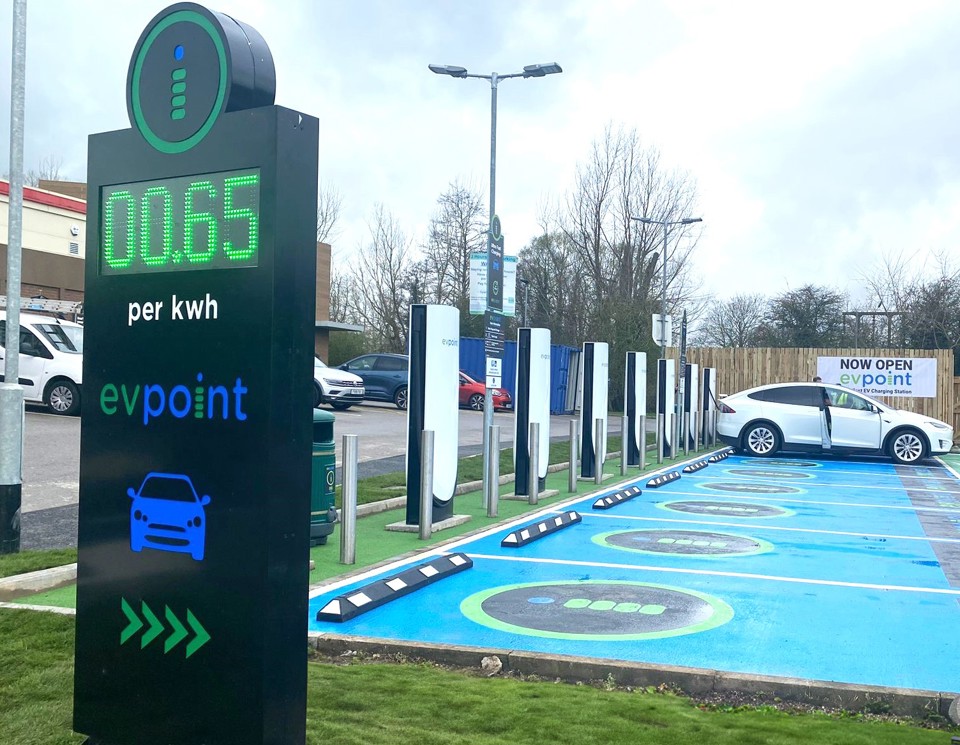Fleets shouldn’t expect to see roadside totems that display prices for electric vehicle (EV) charging, much like diesel and petrol stations, any time soon.
While FairCharge, the EV campaign group, and the RAC have both called for totems to be introduced, Charge UK, which represents the UK’s plug-in vehicle charging industry, says Government regulations do not explicitly require operators to provide pricing on boards.
EG Group is likely to remain an outlier for the time being after its decision in April this year to rollout pricing totems at around 50 of its EV point charging locations, as well as every new location in the future.
Vicky Read, chief executive at Charge UK, told Fleet News: “Our members are committed to making charging as easy and affordable as possible.
“It is interesting to see some operators innovating in this space to present pricing in ways that meet these requirements.
“There is a lot of innovation taking place on pricing and pricing information more generally and we expect to see the market meet customers’ needs in a variety of ways in the coming years.”
The Government has already played down the idea of mandating any pricing totems in the future, with it disagreeing with the Environment and Climate Change Committee and FairCharge recommendations that totems should be considered as part of the next Public Charge Point Regulations review, which it said should happen no later than summer 2025.
The Department for Transport (DfT) deferred policy decisions around agreed symbols and motorway service area signage to National Highways.
A spokesperson for National Highways told Fleet News: “We would support activity that helps to increase the visibility and transparency of EV charging provided it remained in keeping with current rules on motorway service area signage.”
The current rules for MSA signs mandate that they can only hold six pieces of information (logos), plus operator logo, plus location.
Including EV charging prices would mean operators using or losing some of those six pieces of information to make room.
For EV charging, National Highways said it is likely that MSA operators may have more than one EV charging operator which could make the process of showing clearer EV pricing difficult based on differences of brand and speed of charge on offer.
‘Transparent pricing removes uncertainty’
Mohammed Patel, head of energy and utilities (Europe) for EG Group, said the decision to roll out pricing totems was around driving trust with consumers and to boost charging network visibility.
He explained: “Transparent pricing empowers consumers by providing them with clear information about the costs associated with charging their vehicles, allowing them to make informed decisions and effectively manage their spend.
“It removes uncertainty and, ultimately, contributes to a smoother and more convenient charging experience.”
Clear and upfront pricing information also ensures that EV charging services are more likely to be viewed as affordable and accessible by a wider range of users, according to Patel.
He added: “It creates opportunities for more people to participate in the sustainable transportation revolution.”
The current Public Charge Point Regulations 2023, introduced in November last year, do not mandate pricing totems, but instead require charge point operators (CPOs) to display the maximum price of a charging session “either on the charge point or through a separate device”.
Gridserve, which has a network of dedicated rapid charger “superhubs” across the UK, has no current plans to follow EG Group’s lead and introduce pricing totems to its network.
A spokesperson for Gridserve told Fleet News its network is fully compliant with the Public Charge Point Regulations, although it said it is “happy to receive any feedback from its users on how we can improve their experience”.
The Gridserve spokesperson said: “The p/kWh is clearly visible on the digital screens on our units, ahead of charging and while charging, as well as having our pricing URL on printed stickers.
“On our AC chargers which do not have digital screens, pricing is visible on printed stickers as well as the card reader screen.”
Ionity has a network of 186 chargers in the UK and is rapidly working to expand this to 700 by the end of 2024.
Andreas Atkins, Ionity country manager UK & Ireland, said there are no plans to introduce pricing boards, which he described as being “rather imposing to local businesses, residents and drivers”.
He told Fleet News: “We want to keep the UK roads and landscape as uncluttered and green as possible and believe that adding more boards and totems at all locations will not help this.”
He added that customers can receive flexible pricing across the Ionity charging network on their smartphone through the company’s app and Passport subscription service.
All Ionity chargers offer both contactless and flexible tariff options, as well as pricing information on the charger screen.
RAC and FairCharge call for pricing totems

The approach from the charging networks and Government is at odds with what some industry bodies are calling for, however.
The RAC has called on CPOs to introduce clearer roadside signage for p/kWh charging prices as part of the wider FairCharge campaign group’s Electric Charging Public Charter recommendations.
A spokesperson for the RAC said: “Signs on major roads should tell drivers where the fastest chargers are.
“More signage would augment existing information available on public charging apps like Zapmap, as well as through in-car mapping systems.
“This would also help those who are less likely to plan their journeys in advance to recharge as easily as possible.
“In the future, the price per kilowatt hour (kWh) should also be displayed on roadside signs.
“In time, would-be EV drivers would also be able see the scale of the charging network that already exists.”
Charging tsar
Catherine Bowen, BVRLA senior policy advisor, said there is a huge opportunity for improvement when considering how to pay to charge EVs on the public network.
This is in addition to lack of accessibility on the public network, including difficulties for van operators due to bay design and parking restrictions.
The BVRLA also wants to see the ability for charge points to be booked in advance, which is particularly important for fleet operators working to tight timescales to limit vehicle downtime.
Bowen said: “Transparency over rates is vital. Prices should be clear both at the location itself, as well as online so routes can be planned effectively and budgets managed.
“As well as pricing, overall signage of charge points should better inform drivers before pulling up.
“Clear details over the power output, vehicle suitability, and availability should be consistently available.”
Paul Hollick, chair of the Association of Fleet Professionals (AFP), welcomed EG Group’s initiative and said anything that improves consumer confidence around EVs, as well as the quality and visibility of the UK’s public charging network should be applauded.
However, he said that while visibility on price is important for fleet operators, many of the networks are currently charging a similar amount.
Hollick added: “More clarity around availability and the types of chargers available would be a really good development to see in the future.
“Something like a digital information board that car parks have that show the number of available spaces remaining or a ‘no vacancy’ sign.”
Hollick belives that there haven’t been any big misses from the Government’s current Public Charge Point Regulations, but he said the AFP would like to see a “charging tsar” appointed, not to necessarily increase regulation of the public charging sector further, but to make sure it grows in more of a joined up way in the future.
“You have home charging, kerbside, en-route and destination and it’s a full mosaic approach that we’ll need to make EV a success for all drivers in the future,” he added.
“A charging tsar could bring all parties together to make sure we’re moving in the right direction.”





















martinwinlow - 23/05/2024 10:38
I may be wrong but didn't UK petrol stations start displaying their prices a *long* time before the government forced everyone to? It's a pretty obvious way of attracting custom. If I'm right, then it seems likely that, as the industry matures, most charging hubs will want to promote themselves by visibly displaying energy costs - tho it'll get a bit complicated with the additional issue of 'membership rates' etc...